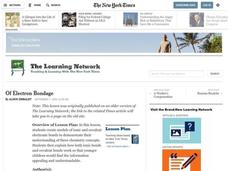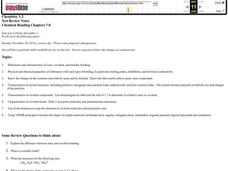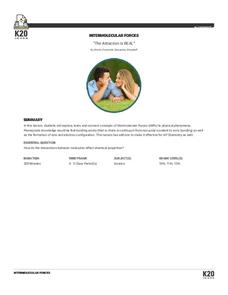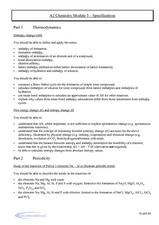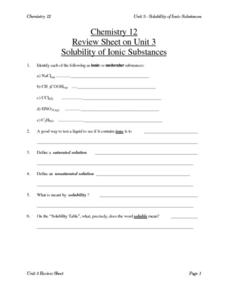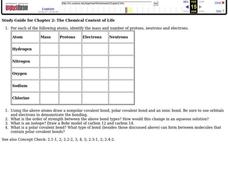Curated OER
Bonding Basics Practice Page
In this chemistry worksheet, students complete each of the bonds listed. They draw the Lewis structures for each atom and show the transfer of electrons and charge for each ion. Students also draw the Lewis structures for each atom and...
Curated OER
Of Electron Bondage
Students create models of ionic and covalent electronic bonds to demonstrate their understanding of these chemistry concepts. They explain how both ionic bonds and covalent bonds work so that younger students can understand.
Curated OER
AP Chemistry Chapter 9
In this AP Chemistry worksheet, students apply concepts of electron configuration to accurately answer the questions provided. Students also draw Lewis structures of the given elements. Students estimate the enthalpy of formation as well...
Curated OER
Ionic and Covalent Bonds
Ionic and covalent bonds are the focus of this chemistry activity, which provides learners with eighteen key terms to use in a fill-in-the-blank activity. Additionally, students are prompted to write the number of atoms in four given...
Curated OER
Review for Chemistry
In this review for chemistry learning exercise, students decide if given statements are true or false. Students relate information learned about introductory knowledge gained in chemistry to accurately answer the given questions.
Curated OER
Chemical Bonding
For this bonding worksheet, students review topics associated with chemical bonding including, ionic and covalent bonding, shapes of molecules, and writing chemical formulas. This worksheet has 8 problems to solve.
Curated OER
Chemical Bonding
In this chemical bonding instructional activity, students explain the difference between ionic and covalent bonding, determine the shapes of molecules, and write chemical formulas. This instructional activity has 6 problems to solve.
Virginia Department of Education
A Crystal Lab
Young chemists grow ionic crystals, metallic crystals, and supersaturated crystals in three different lab experiments. Observing these under a microscope allows pupils to compare the various structures.
Curated OER
IPC Review
Learners discuss the difference between atoms and elements. They analyze how compounds are formed. Students discuss the difference between covalent bonds, hydrogen bonds, and ionic bonds. They review bonding with diagrams, "Atoms or...
K20 LEARN
The Attraction is REAL
How attractive is your intermolecular forces lesson plan? Draw your class in with an activity that includes research, presentation, and demonstrations. Chemistry scholars work together to create claims about the each intermolecular...
Curated OER
Comparing Covalent and Ionic Substances
In this covalent and ionic substances worksheet, students use the internet to find information about the characteristics of covalent and ionic substance and explain what causes the differences in these types of substances.
Curated OER
Chemistry Module 5 - Specifications
While this resource does not provide problems for chemistry learners to solve, it outlines skills that they should have and concepts that they should grasp. Topics include thermodynamics, periodicity, redox equilibria, transition metals,...
Pearson
The Chemical Context of Life
An educational presentation includes atoms, molecules, the four major elements, as well as neutrons and protons. Additionally, slides focus on atomic number, mass number, atomic weight, polar and nonpolar covalent bonding, ionic bonds,...
Curated OER
Solubility of Ionic Substances
In this solubility worksheet, students identify substances as either ionic or molecular, define saturated solution and solubility, and calculate concentration of solutions. This worksheet has 7 short answer, 5 fill in the blank, and 27...
Curated OER
Introduction to Bonding
In this chemistry worksheet, students create new and true statements while replacing false ones in order to properly define parts of the concept of bonding.
Curated OER
Recognizing Polar Molecules
For this polar molecules worksheet, students complete a graphic organizer by writing in the bond type, electron dot diagram, and the type of compound for the chemical compounds given.
Biology Junction
Chemistry
You matter—unless you multiply yourself by the speed of light squared, then you energy! Scholars learn about matter, energy, the elements and so much more using an informative presentation. Completing the included worksheet creates a...
Royal Society of Chemistry
Halide Ion Tests
Young chemists love it when colorful solid products appear in a reaction vessel! Scholars discover the products that form during halide ion tests through a hands-on activity. Users go online and apply chemistry knowledge and reasoning...
Curated OER
Chemical Bonding
In this chemical compounds worksheet, high schoolers review the different types of bonding, define the octet rule, and draw Lewis structures (electron-dot diagrams) for given compounds. This worksheet has 7 fill in the blank, 5 short...
Curated OER
Intermolecular Forces Worksheet
In this intermolecular forces worksheet, learners answer 4 questions about the forces between atoms within molecules and compounds. Students rank the boiling points of compounds based on their intermolecular forces and they explain...
Curated OER
Physical Science Quiz
Test your class with a physical science quiz. Learners explain chemical processes, name compounds, write formulas for chemical compounds, balance equations, and more.
Curated OER
A Little Chemistry
The molecular properties of water are the focus of this chemistry-based assignment. Multiple-choice, true-or-false, matching, and fill-in-the-chart style questions query assignees about the forces that hold the water molecule together,...
Curated OER
The Chemical Context of Life
In this chemistry worksheet, young scholars fill in the chart for question one. The chart is filled out examining the mass, protons, electrons, and neutrons for specific atoms.
Curated OER
Chemistry Unit on Compounds, Formulas, and Equations
Students perform a review assignment in 3 portions to review chemistry compounds, formulas, and equations. The assignment consists of several different portions that can be used as assessments. The majority of the lesson plan is composed...



